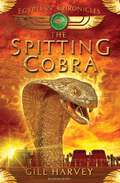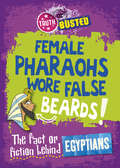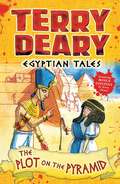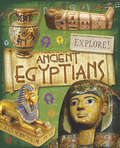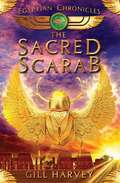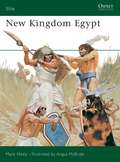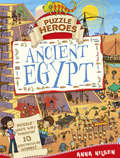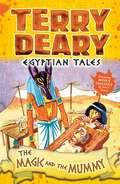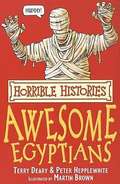Special Collections
Excellent Egyptians
Description: Accessible images and books for special topics
- Table View
- List View
The Spitting Cobra
by Gill HarveyThe Spitting Cobra is the first in a new series of four books set in ancient Egypt. Each book is a fantastically atmospheric evocation of Egyptian life encased in an exciting adventure story. The boy and girl characters, Hopi and Isis, feature in each book and readers will be intrigued to follow their struggles for existence and adventure in Egypt circa 1150 BC.The Spitting Cobra opens the series with a gripping adventure of royal proportions as Hopi and Isis, orphaned when crocodiles kill their parents, are due to perform for the Pharoah's tomb builders near the legendary Valley of the Kings. But the villagers fall under suspicion when the heavily guarded royal tombs are broken into. Can Isis and Hopi discover the truth about the robberies - in time?
Egyptian dwarf god Bes (UEB Contracted)
by Rnib BookshareThis is an image of the god Bes known as the protector of childbirth and children. There is a locator dot shown, which will be at the top left of the page when the image is the right way up. He is standing facing forward so all of his face and limbs can be seen. At the top centre of the page is Bes's tall hat with lines running vertically down it. Down the page from this are his eyebrows, two eyes, nose, mouth and beard. His very large ears stick out to either side of his large head. He does not have any neck so that his arms, held outwards with two bracelets on each, appear to grow out of his head. On his chest, he wears an Ankh symbol, thought to represent eternal life and life after death. It is hanging on a necklace, which is not shown. Further down the page are Bes's naval, a loincloth and his two short legs.
Egyptian god Amun Ra (UEB uncontracted)
by RnibThis picture shows Ra the sun god in one of his many forms with the head of a falcon and the body of a man. There is a locator dot shown, which will be at the top left of the page when the image is the right way up. He is standing with his head and legs facing to the right, so only one eye can be seen. His arms and chest are facing forward. At the top of the page Ra is wearing the Uraeus, a headdress symbolising the goddess Wadjit in the form of a cobra with its head to the right, draped over the sun-disc. Down the page from this is Ra's falcon head with its one visible eye and beak to the right with his long hair to the left. He is wearing a wide ornamental Egyptian collar. In the middle of the page is Ra's chest facing forward with a hand on the left pointing down and holding an Ankh. His other hand, on the right holds the staff of life. He wears two bracelets on each of his arms and a gold band around his chest. Around his waist is a short kilt reaching down to his knees and down from this can be found two anklets with his feet below them pointing to the right.
The Fact or Fiction Behind the Egyptians
by Kay BarnhamTruth or Busted's ancient Egyptians title explores popular myths and legends about one of history's most fascinating periods in a tongue-in-cheek, humorous way that kids will find unputdownable! Alongside features such as 'Pharoah Phact Phile' in which we learn about some of Egypt's wackiest rulers, Truth or Busted statements such as 'The ancient Egyptians used children as scarecrows' or 'Ground-up mummies were used as medicine' are explored. We look at where the idea came from, whether it has any basis in truth, or whether they can be consigned to folklore. Finally, each statement is given a TRUTH or BUSTED evaluation! A must for anyone interested in the Egyptians, or studying history at school!
Egyptian Tales
by Terry DearyFrom the bestselling author of Horrible Histories...The Great Pyramid is a lively place to work. The only irritation is Antef, the fussy, bullying supervisor who makes everyone feel more like slaves than free workers. So, when Antef disappears, the workers are blamed. The only witness is yong Dafia. Can she decides to come up with a plan to clear the men's names?Terry Deary's Egyptian Tales explore the world of Ancient Egypt through the eyes of children who could have lived at the time. These stories feature real people and take place in some of the most recognisable Egyptian settings. This new edition features notes for the reader to help extend learning and exploration of the historical period.
Egyptian hieroglyphs (UEB uncontracted)
by RnibThis is a multi page image set on two pages with nine hieroglyphs on each page. A locator dot and title are shown on both pages. These must always be at the top left of the page when the image is the right way up. Nine Egyptian hieroglyphs. Nine Egyptian hieroglyphs are shown on this page. They are arranged in three columns of three images. Each hieroglyph has a label above or to its right, showing what is depicted in the symbol, and what letter or letters it represents. At the top left is a forearm representing "a". The hand is to the left and elbow to the right, with part of the upper arm shown above it. Down from this is the foot which represents ""b"". It is a side view with the toes to the left and the heel to the right. Part of the lower leg is shown going up the page from the heel. At the bottom left there is a tethered rope symbol representing "ch". It shows a rope which folds on the right and has two loops on the left. At the top centre of the page is the hand symbol which represents "d". This shows a hand with the wrist to the right and the straight thumb and fingers to the left. Down from the hand is the vulture symbol which symbolises "e". This is a side view of a vulture which faces to the left. One of its eyes can be found along with a curved beak. Its body is partially covered by a folded wing, and both legs are shown. Its tail droops towards the bottom right of the image. At the bottom centre is the pot stand symbol representing "g". This is a side view with a line across the top and bottom of the shape, and a triangular opening in the bottom centre. In the top right corner is a rope symbol which represents "h". The ends of the rope are at the bottom of the symbol. The rope is loosely twisted around itself, ending in a loop at the top. Down from the rope is the shelter symbol also representing "h". It is like a simple floor plan with the entrance in the bottom left of the symbol and the walls shown as a thick line. At the bottom right of the page is the reed leaf symbol which represents "i". The stem at the bottom of the symbol leads up to the blade-shaped leaf. Another nine Egyptian hieroglyphs. This page depicts nine more Egyptian hieroglyphs in three columns of three images. Each hieroglyph has a label above or to its right showing what is depicted in the symbol, and what letter or letters it represents. At the top left of the page is the cobra symbol representing "j". The snake is viewed from the side, with its head at the top left, and long body curving down and right. Down from this is the basket symbol representing "k". The basket is seen from the side, with four layers showing which get wider towards the top. A handle extends out to the right from the top layer. At the bottom left is the water symbol representing "n". It is a thick zigzag line. At the top centre of the page is the stool symbol representing "p". It is a view from above, looking down onto the stripe-patterned seat. Down from this is the folded cloth symbol representing "s". It is a simple vertical line which curves back on itself at the top. At the bottom centre is the bread loaf symbol which represents "t". The loaf is represented by a simple semi-circle. In the top right corner is the sieve symbol representing "th". It is an open circle with horizontal lines. Down from this is the cow's belly symbol representing "th". It has an oval at the right which is joined to a circle with six spikes at its left. At the bottom right is the door bolt symbol representing "z". It is a long thin horizontal shape with two short vertical lines crossing it towards the middle.
Egyptian hieroglyphs (UEB Contracted)
byThis is a multi page image set on two pages with nine hieroglyphs on each page. A locator dot and title are shown on both pages. These must always be at the top left of the page when the image is the right way up. Nine Egyptian hieroglyph: Nine Egyptian hieroglyphs are shown on this page. They are arranged in three columns of three images. Each hieroglyph has a label above or to its right, showing what is depicted in the symbol, and what letter or letters it represents. At the top left is a forearm representing a. The hand is to the left and elbow to the right, with part of the upper arm shown above it. Down from this is the foot which represents b. It is a side view with the toes to the left and the heel to the right. Part of the lower leg is shown going up the page from the heel. At the bottom left there is a tethered rope symbol representing ch. It shows a rope which folds on the right and has two loops on the left. At the top centre of the page is the hand symbol which represents d. This shows a hand with the wrist to the right and the straight thumb and fingers to the left. Down from the hand is the vulture symbol which symbolises e. This is a side view of a vulture which faces to the left. One of its eyes can be found along with a curved beak. Its body is partially covered by a folded wing, and both legs are shown. Its tail droops towards the bottom right of the image. At the bottom centre is the pot stand symbol representing g. This is a side view with a line across the top and bottom of the shape, and a triangular opening in the bottom centre. In the top right corner is a rope symbol which represents h. The ends of the rope are at the bottom of the symbol. The rope is loosely twisted around itself, ending in a loop at the top. Down from the rope is the shelter symbol also representing h. It is like a simple floor plan with the entrance in the bottom left of the symbol and the walls shown as a thick line. At the bottom right of the page is the reed leaf symbol which represents i. The stem at the bottom of the symbol leads up to the blade-shaped leaf. Another nine Egyptian hieroglyphs: This page depicts nine more Egyptian hieroglyphs in three columns of three images. Each hieroglyph has a label above or to its right showing what is depicted in the symbol, and what letter or letters it represents. At the top left of the page is the cobra symbol representing j. The snake is viewed from the side, with its head at the top left, and long body curving down and right. Down from this is the basket symbol representing k. The basket is seen from the side, with four layers showing which get wider towards the top. A handle extends out to the right from the top layer. At the bottom left is the water symbol representing n. It is a thick zigzag line. At the top centre of the page is the stool symbol representing p. It is a view from above, looking down onto the stripe-patterned seat. Down from this is the folded cloth symbol representing s. It is a simple vertical line which curves back on itself at the top. At the bottom centre is the bread loaf symbol which represents t. The loaf is represented by a simple semi-circle. In the top right corner is the sieve symbol representing th. It is an open circle with horizontal lines. Down from this is the cow's belly symbol representing th. It has an oval at the right which is joined to a circle with six spikes at its left. At the bottom right is the door bolt symbol representing z. It is a long thin horizontal shape with two short vertical lines crossing it towards the middle.
Ancient Egyptians
by Jane BinghamThis photographic book gives you an overview of Ancient Egyptians. From the early kingdoms to the mighty pharaohs that led the Eqyptian world. Learn about Egyptian religion and beliefs, life for ordinary people and the brilliant buildings. We also look at the food, medicine, science, music and art of the time. You can read about a day at temple school and learn to write in hieroglyphics.
Egyptian goddess Isis (large print)
by RnibThis picture shows Isis, the goddess of motherhood and childbirth and the mother of Horus. There is a locator dot shown, which will be at the top left of the page when the image is the right way up. She is standing with her head and legs facing to the right so only one eye can be seen. Her arms and chest are facing forward. At the top of the page is Isis's headdress with two horns. Down the page a vulture is sitting on her head with its beak to the right. Down again is her face looking to the right with one eye, nose and mouth to the right and hair to the left. Around her neck she is wearing a wide Egyptian collar. In the middle of the page Isis's chest can be found. She has an arm with hand raised on the right, and to the left she holds an Ankh. She wears bracelets on her arms and wrists. Isis is wearing a long dress that covers her chest and goes down the page to her ankles. Her two feet are at the bottom of the page facing to the right.
Egyptian god Khnum (Large Print)
by Rnib BookshareThis is an image of Khnum, the ram-headed god of water who created the egg from which the sun hatched. There is a locator dot shown, which will be at the top left of the page when the image is the right way up. He is standing with his head and legs facing to the right, so only one eye can be seen. His arms and chest are facing forward. At the top of the page are Khnum's two ram horns, pointing to the left and right. Down from these is his head with one eye, nose and mouth visible on the right, and his long hair on the left, falling on to his chest and wide ornamental Egyptian collar. On his torso, he wears a short vest. He has one arm to the left with its hand holding an Ankh and the other to the right, holding the staff of life. He wears two bracelets on each arm. Down the page Khnum wears a short kilt to the knee, held at the waist with a brooch. His bare legs and right-facing feet are at the bottom of the page.
Egyptian god Khnum (UEB Contracted)
by Rnib BookshareThis is an image of Khnum, the ram-headed god of water who created the egg from which the sun hatched. There is a locator dot shown, which will be at the top left of the page when the image is the right way up. He is standing with his head and legs facing to the right, so only one eye can be seen. His arms and chest are facing forward. At the top of the page are Khnum's two ram horns, pointing to the left and right. Down from these is his head with one eye, nose and mouth visible on the right, and his long hair on the left, falling on to his chest and wide ornamental Egyptian collar. On his torso, he wears a short vest. He has one arm to the left with its hand holding an Ankh and the other to the right, holding the staff of life. He wears two bracelets on each arm. Down the page Khnum wears a short kilt to the knee, held at the waist with a brooch. His bare legs and right-facing feet are at the bottom of the page.
Egyptian goddess Bastet (UEB uncontracted)
by RnibThis picture shows the cat-goddess Bastet. There is a locator dot shown, which will be at the top left of the page when the image is the right way up. She was protector of the pharaoh and the sun god Ra, sometimes known as the Eye of Ra. She is standing with her head and legs facing to the right so only one eye can be seen. Her arms and chest are facing forward. At the top of the page is Bastet's cat ear. Down the page is her head with one eye, cat nose and mouth visible to the right, and her long hair to the left. She wears a wide, heavy Egyptian collar and a long dress reaching down to her ankles with decorative trim at the bottom. Her chest faces forwards and she has one hand held up to the right, with the other to the left, holding a staff with an Ankh symbol on.
Egyptian god Amun Ra (UEB contracted)
by RnibThis picture shows Ra the sun god in one of his many forms with the head of a falcon and the body of a man. There is a locator dot shown, which will be at the top left of the page when the image is the right way up. He is standing with his head and legs facing to the right, so only one eye can be seen. His arms and chest are facing forward. At the top of the page Ra is wearing the Uraeus, a headdress symbolising the goddess Wadjit in the form of a cobra with its head to the right, draped over the sun-disc. Down the page from this is Ra's falcon head with its one visible eye and beak to the right with his long hair to the left. He is wearing a wide ornamental Egyptian collar. In the middle of the page is Ra's chest facing forward with a hand on the left pointing down and holding an Ankh. His other hand, on the right holds the staff of life. He wears two bracelets on each of his arms and a gold band around his chest. Around his waist is a short kilt reaching down to his knees and down from this can be found two anklets with his feet below them pointing to the right.
An Ancient Egyptian tomb (UEB contracted)
by RnibThis is image is a plan view of a typical Egyptian tomb showing an annexe, a treasure room, antechamber and burial chamber. There is a locator dot shown, which will be at the top left of the page when the image is the right way up. The plan is bounded by a dashed line image border. On the bottom left of the page is the entrance into an antechamber filled with treasures and artefacts. At the top left of the page is an annexe with more valuable objects. At the right side of the antechamber there are two statues of the king and to the right of these is the entrance to the burial chamber containing the coffin. The wall to the right of the coffin is decorated. At the bottom right of the page is a treasure room with a golden shrine and an image of Anubis, god of the funeral cult and carer for the dead.
The Sacred Scarab
by Gill HarveyThe third in a new series of four books: the first and second titles were published in August and October 2009, the fourth to be published in April 2010.Fantastically atmospheric evocations of Egyptian life are encased in an exciting adventure story. Each story features the boy and girl characters Hopi and Isis, and their struggles for existence and adventure in Egypt circa 1150 BC. In this story, The Sacred Scarab, Hopi and Isis, orphaned when crocodiles kill their parents, are preparing for an important festival, in which the king accompanies the gods to his great mortuary temple. But when Isis and Hopi uncover a plot by a villainous tax collector, they need to ensure that justice is done . . . The author has spent much time in Egypt and the stories are meticulously researched.The books include factual detail and notes about Egyptian lifestyle, the importance of the gods for the Egyptians, the tombs and much more.
New Kingdom Egypt
by Mark Healy and Angus McBrideBuilders of the Pyramids and most ancient of all the powers of the biblical world, the Egyptians remain one of history's most fascinating and enigmatic peoples. During the New Kingdom era, Egypt reached the peak of its power, wealth, and territory. Through the intensive military campaigns of Pharaoh Thutmose III (1490-1436BC), Palestine, Syria, and the northern Euphrates area in Mesopotamia were all brought within the New Kingdom. Mark Healy outlines the history, organisation and dress of the New Kingdom Egyptians in this volume packed with accompanying illustrations and photographs, including 12 full page colour plates by the ever popular Angus McBride.
Ancient Egypt
by Anna NilsenDive into the world of Ancient Egypt and help save Granny from an ancient curse by completeing the puzzles in the book.Puzzle Heroes is an interactive series of very fun, visually-led books containing an adventure or challenge on every page. There are plenty of search-and-find elements in the style of Where's Wally?, combined with topics of educational value, where fun facts help with the challenges. This gives plenty of opportunity to use the book as an extra learning tool - but ultimately the quests are fantastic fun, engrossing readers to the extent that they won't realise they are learning.
Egyptian Tales
by Terry Deary and Helen FlookFrom the bestselling author of Horrible Histories...This is a tale of Neria, who works in the House of Death helping her father to make mummies. Neria enjoys her work, but when the pharaoh dies, everyone is so busy that Neria is given the responsibility of mummifying the pharaoh's cat, to accompany him to the afterlife. The trouble is, Neria doesn't want to kill and gut the cat! Can she find a way to save it - without being caught and punished?Terry Deary's Egyptian Tales explore the world of Ancient Egypt through the eyes of children who could have lived at the time. These stories feature real people and take place in some of the most recognisable Egyptian settings. This new edition features notes for the reader to help extend learning and exploration of the historical period.
Egyptian goddess Isis (Large Print)
by Rnib BookshareThis picture shows Isis, the goddess of motherhood and childbirth and the mother of Horus. There is a locator dot shown, which will be at the top left of the page when the image is the right way up. She is standing with her head and legs facing to the right so only one eye can be seen. Her arms and chest are facing forward. At the top of the page is Isis's headdress with two horns. Down the page a vulture is sitting on her head with its beak to the right. Down again is her face looking to the right with one eye, nose and mouth to the right and hair to the left. Around her neck she is wearing a wide Egyptian collar. In the middle of the page Isis's chest can be found. She has an arm with hand raised on the right, and to the left she holds an Ankh. She wears bracelets on her arms and wrists. Isis is wearing a long dress that covers her chest and goes down the page to her ankles. Her two feet are at the bottom of the page facing to the right.
Egyptian god Osiris (UEB Contracted)
by Rnib BookshareThis is an image of Osiris; judge of the dead and also god of rebirth, he exerted his power over the flooding of the river Nile and the greening of Egypt. There is a locator dot shown, which will be at the top left of the page when the image is the right way up. He is standing with his head and legs facing to the right, so only one eye can be seen. His arms and chest are facing forward. At the top of the page is Osiris's conical crown with red plumes to either side. Down the page from this is his head with one eye, nose, mouth and beard visible to the right. His skin is green. Around his neck, he wears an ornamental Egyptian collar of red and blue. Down the page his abdomen is facing forward with his elbows extending out on both sides. His hands are on his chest; the one on the left holds a flail and the one on the right a crook. Down the page Osiris wears a sash around his waist. He is wrapped to the ankles in strips of linen similar to a mummy and has green feet facing to the right.
Egyptian dwarf god Bes (UEB contracted)
by RnibThis is an image of the god Bes known as the protector of childbirth and children. There is a locator dot shown, which will be at the top left of the page when the image is the right way up. He is standing facing forward so all of his face and limbs can be seen. At the top centre of the page is Bes's tall hat with lines running vertically down it. Down the page from this are his eyebrows, two eyes, nose, mouth and beard. His very large ears stick out to either side of his large head. He does not have any neck so that his arms, held outwards with two bracelets on each, appear to grow out of his head. On his chest, he wears an Ankh symbol, thought to represent eternal life and life after death. It is hanging on a necklace, which is not shown. Further down the page are Bes's naval, a loincloth and his two short legs.
Flag of Egypt (UEB contracted)
by Rnib BookshareThis page shows two images: the flag of Egypt at the top of the page and an enlarged image of the coat of arms of Egypt at the bottom of the page. There is a locator dot shown, which will be at the top left of the page when the image is the correct way up. A key at the top left of the tactile page shows the colours used on the flag. The flag, at the top of the page, has three horizontal stripes with the coat of arms of Egypt in the centre of the image. The enlarged image of the coat of arms is at the bottom of the page. It shows the Eagle of Saladin. Its head, facing to the left, is at the top of the image and its wings are to either side. In the centre of the eagle's body, there is a shield shape with three vertical stripes in it. Down the page is the eagle's tail and down again is an inscription in Arabic reading Arab Republic of Egypt from right to left.
The Awesome Egyptians (Horrible Histories)
by Terry Deary and Martin Brown and Peter HepplewhiteStep back to an awesomely ancient time with the Awesome Egyptians. Discover which king had the worst blackheads, why some kings had to wear false beards and why the peasants were revolting. History with the nasty bits left in! 2013 is HORRIBLE HISTORIES twentieth anniversary.
Egyptian god Osiris (Large Print)
by Rnib BookshareThis is an image of Osiris; judge of the dead and also god of rebirth, he exerted his power over the flooding of the river Nile and the greening of Egypt. There is a locator dot shown, which will be at the top left of the page when the image is the right way up. He is standing with his head and legs facing to the right, so only one eye can be seen. His arms and chest are facing forward. At the top of the page is Osiris's conical crown with red plumes to either side. Down the page from this is his head with one eye, nose, mouth and beard visible to the right. His skin is green. Around his neck, he wears an ornamental Egyptian collar of red and blue. Down the page his abdomen is facing forward with his elbows extending out on both sides. His hands are on his chest; the one on the left holds a flail and the one on the right a crook. Down the page Osiris wears a sash around his waist. He is wrapped to the ankles in strips of linen similar to a mummy and has green feet facing to the right.
Egyptian goddess Bastet (Large Print)
by Rnib BookshareThis picture shows the cat-goddess Bastet. There is a locator dot shown, which will be at the top left of the page when the image is the right way up. She was protector of the pharaoh and the sun god Ra, sometimes known as the Eye of Ra. She is standing with her head and legs facing to the right so only one eye can be seen. Her arms and chest are facing forward. At the top of the page is Bastet's cat ear. Down the page is her head with one eye, cat nose and mouth visible to the right, and her long hair to the left. She wears a wide, heavy Egyptian collar and a long dress reaching down to her ankles with decorative trim at the bottom. Her chest faces forwards and she has one hand held up to the right, with the other to the left, holding a staff with an Ankh symbol on.
